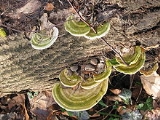
Trametes
Encyclopedia
Trametes is a genus
of fungi that is distinguished by a pileate basidiocarp, di- to trimitic hyphal systems, smooth non-dextrinoid spores
, and a hymenium
usually without true hymenial cystidia
. The genus has a widespread distribution and contains about fifty species. The genus was first described by Elias Magnus Fries
in 1835.
Trametes fungi are food for caterpillar
s of certain Lepidoptera
, mainly fungus moths (Tineidae) such as Triaxomera parasitella
.
Genus
In biology, a genus is a low-level taxonomic rank used in the biological classification of living and fossil organisms, which is an example of definition by genus and differentia...
of fungi that is distinguished by a pileate basidiocarp, di- to trimitic hyphal systems, smooth non-dextrinoid spores
Spore
In biology, a spore is a reproductive structure that is adapted for dispersal and surviving for extended periods of time in unfavorable conditions. Spores form part of the life cycles of many bacteria, plants, algae, fungi and some protozoa. According to scientist Dr...
, and a hymenium
Hymenium
The hymenium is the tissue layer on the hymenophore of a fungal fruiting body where the cells develop into basidia or asci, which produce spores. In some species all of the cells of the hymenium develop into basidia or asci, while in others some cells develop into sterile cells called cystidia or...
usually without true hymenial cystidia
Cystidium
A cystidium is a relatively large cell found on the hymenium of a basidiomycete , often between clusters of basidia. Since cystidia have highly varied and distinct shapes that are often unique to a particular species or genus, they are a useful micromorphological characteristic in the...
. The genus has a widespread distribution and contains about fifty species. The genus was first described by Elias Magnus Fries
Elias Magnus Fries
-External links:*, Authors of fungal names, Mushroom, the Journal of Wild Mushrooming.*...
in 1835.
Trametes fungi are food for caterpillar
Caterpillar
Caterpillars are the larval form of members of the order Lepidoptera . They are mostly herbivorous in food habit, although some species are insectivorous. Caterpillars are voracious feeders and many of them are considered to be pests in agriculture...
s of certain Lepidoptera
Lepidoptera
Lepidoptera is a large order of insects that includes moths and butterflies . It is one of the most widespread and widely recognizable insect orders in the world, encompassing moths and the three superfamilies of butterflies, skipper butterflies, and moth-butterflies...
, mainly fungus moths (Tineidae) such as Triaxomera parasitella
Triaxomera parasitella
Triaxomera parasitella is a species of tineoid moth. It belongs to the fungus moth family , and therein to the subfamily Nemapogoninae. It is widespread and common in much of western Eurasia, but seems to be absent from some more outlying regions, such as Portugal and the eastern Baltic, Ireland...
.
Species
- Trametes gibbosaTrametes gibbosaTrametes gibbosa, commonly known as the 'lumpy bracket', is a polypore mushroom that causes a white rot. It is found on beech stumps and the dead wood of other hardwood species. Fruit bodies are 8–15 cm in diameter and semicircular in shape. The upper surface is usually gray or white, but may...
- Trametes hirsutaTrametes hirsutaTrametes hirsuta is a plant pathogen. It is found on dead wood of deciduous trees, especially beechwood. It is found all year round and persists due to its leathery nature.- External links :* *...
- Trametes nivosaTrametes nivosaTrametes nivosa is a plant pathogen.- External links :* *...
- Trametes pubescensTrametes pubescensTrametes pubescens is a plant pathogen.- External links :* *...
- Trametes versicolorTrametes versicolorTrametes versicolor — formerly known as Coriolus versicolor and Polyporus versicolor — is an extremely common polypore mushroom which can be found throughout the world. Versicolor means 'of several colours' and it is true that this mushroom is found in a wide variety of different colours. T...

